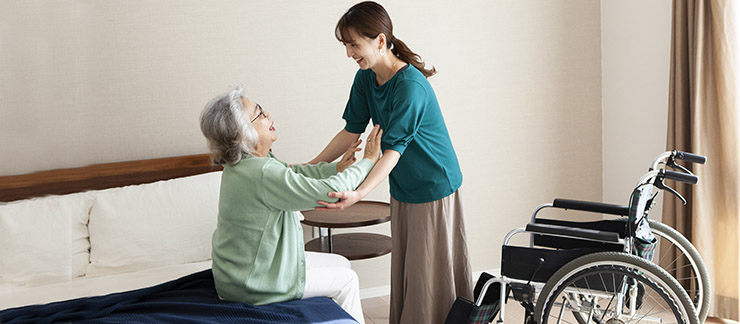
How to Help an Elderly Loved One Transfer Safely
Helping an elderly loved one to move safely to another place or position—or “transfer”— is an essential responsibility for a family caregiver. Transfer support happens when a senior needs physical assistance getting:
- In and out of the shower or tub
- On and off the toilet
- Up from or into a chair
- In and out of bed
Ensuring the well-being of seniors is vital as they navigate their daily lives. Providing essential support and guidance can help them safely move around their home, venture outdoors, or engage in daily activities.
Top Transferring Tips for Caregivers
Facilitating safe and smooth transfers for your elderly loved one can be achieved through various effective methods. To help you move or transfer your loved one with confidence and security, our experts from Visiting Angels have compiled the following tips and strategies:
- Communicate with your senior
Just like it’s challenging to transfer someone, it can also be difficult to be transferred. Clearly communicating with your senior about what needs to be done throughout the transfer can instill trust and confidence for both of you—and help you avoid tripping or accident risks.
- Avoid long earrings and necklaces
If your senior feels they’re going to fall, they may reach out for the nearest handhold—even if it is attached to you. Keep dangling jewelry off and long hair pulled back to reduce the risk of skin and neck injuries.
- Use assistive devices
Certain devices allow you to lift your senior with more stability. Ask a doctor about assistive devices, such as grab bars, walkers, motorized chair lifts, and gait belts, that could make transferring safer and easier. Do not use a gait belt unless instructed on its use.
- Be extra careful in the bathroom
About 80% of home falls happen in the bathroom due to tight quarters, out-of-place clothing, and water on the floor. Give yourselves extra time and ensure solid footing before attempting to transfer. Monitor for tripping hazards like loose rugs, and place non-slip mats on the floor to reduce fall risks.
- Lift with your legs, not your back
Your legs are the source of strength for movement and lifting. Lifting with your back makes you susceptible to back injury and pain. Powering up from your legs keeps you steadier and gives you more strength than hunching over to transfer your loved one.
- Seek medical advice
Take your senior to see a doctor or physical therapist before they need help with transferring. The provider can evaluate your unique situation and offer tips for you both to transfer safely.
It’s OK to Ask for Transfer Help
Transferring doesn’t have to be a source of anxiety for you and your senior. You should feel empowered to seek help transferring a loved one when needed. As your senior gets older, they may be less able to move independently, which can take a physical and mental toll on you.
Visiting Angels is the in-home assistance you need when transferring your loved one becomes difficult. By providing personalized senior care and support, our professional caregivers can help your loved one maintain their mobility and independence while ensuring safety and comfort during transfers.


